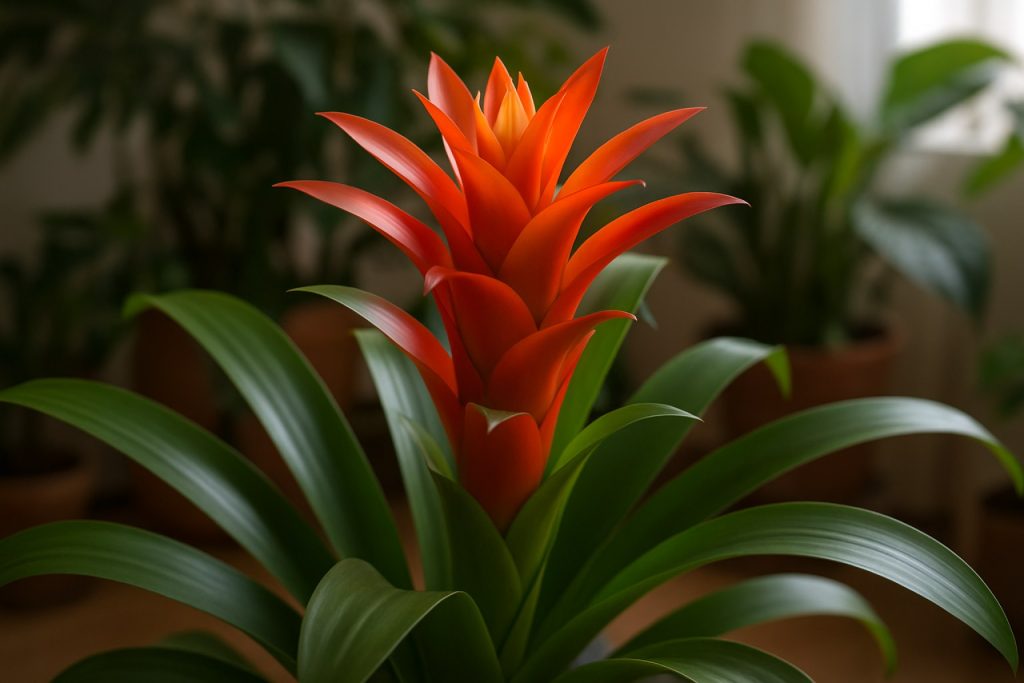
Discover the Allure of Guzmania: The Vibrant Bromeliads Redefining Tropical Elegance. Explore Their Unique Biology, Care Secrets, and Ornamental Power.
- Introduction to Guzmania: Origins and Classification
- Distinctive Morphology and Color Variations
- Natural Habitats and Ecological Roles
- Propagation Techniques and Growth Cycles
- Optimal Cultivation: Light, Water, and Soil Needs
- Common Pests, Diseases, and Troubleshooting
- Guzmania in Interior Design and Landscaping
- Conservation Status and Sustainability Concerns
- Hybridization and Notable Cultivars
- Future Trends and Research in Guzmania Studies
- Sources & References
Introduction to Guzmania: Origins and Classification
Guzmania is a prominent genus within the Bromeliaceae family, comprising over 120 recognized species of tropical plants. These epiphytic and terrestrial plants are native primarily to the rainforests of Central and South America, with their natural range extending from southern Florida and the West Indies through Mexico, Central America, and into northern and western regions of South America. The genus was first described in the early 19th century and is named in honor of Anastasio Guzmán, a Spanish naturalist and pharmacist who contributed to botanical exploration in South America.
Taxonomically, Guzmania belongs to the subfamily Tillandsioideae, which is characterized by soft, often spineless leaves and the absence of water-holding tanks that are typical in some other bromeliads. The genus is closely related to other bromeliads such as Tillandsia and Vriesea, sharing similar floral structures and ecological adaptations. Guzmania species are distinguished by their rosettes of strap-shaped leaves and striking inflorescences, which often feature brightly colored bracts in shades of red, orange, yellow, or purple. These bracts surround the small, tubular flowers and play a key role in attracting pollinators such as hummingbirds.
The classification of Guzmania has been refined over time through morphological and molecular studies. Botanists use characteristics such as leaf arrangement, inflorescence structure, and floral morphology to differentiate species within the genus. Recent advances in DNA analysis have further clarified relationships within the Bromeliaceae family, supporting the monophyly of Guzmania and helping to resolve taxonomic ambiguities. The genus is recognized and cataloged by major botanical authorities, including the Royal Botanic Gardens, Kew, which maintains the World Checklist of Selected Plant Families, and the Missouri Botanical Garden, both of which are leading institutions in plant taxonomy and conservation.
Guzmania species are ecologically significant in their native habitats, often growing as epiphytes on trees where they contribute to the biodiversity and structure of tropical forest canopies. Their ability to thrive in low-light, humid environments has also made them popular as ornamental houseplants worldwide. The genus continues to be a subject of horticultural interest and scientific study, reflecting its importance in both natural ecosystems and cultivated settings.
Distinctive Morphology and Color Variations
Guzmania, a prominent genus within the Bromeliaceae family, is renowned for its striking morphological features and vibrant color variations. These epiphytic or terrestrial plants are native primarily to the tropical regions of Central and South America, where their unique adaptations allow them to thrive in diverse environments. The most distinctive aspect of Guzmania morphology is the rosette arrangement of their leaves, which are typically smooth, strap-shaped, and arching. This rosette structure not only aids in water collection but also provides a reservoir for nutrients and microfauna, a common adaptation among bromeliads.
The leaves of Guzmania species are generally soft and flexible, lacking the spines or serrations found in some other bromeliads. Leaf coloration ranges from various shades of green to deep burgundy, sometimes with subtle banding or mottling, depending on the species or cultivar. The central tank formed by the leaf rosette is a hallmark of the genus, serving as a water storage system that supports the plant during dry periods.
Perhaps the most visually arresting feature of Guzmania is its inflorescence. The flowering stalk, or scape, emerges from the center of the rosette and is often surrounded by brightly colored bracts. These bracts, which can persist for several months, are typically red, orange, yellow, pink, or even purple, and are frequently mistaken for the actual flowers. The true flowers are usually small, tubular, and less conspicuous, often white or yellow, and are nestled among the showy bracts. This vivid display serves to attract pollinators such as hummingbirds and insects, which are essential for the plant’s reproductive cycle.
Color variation in Guzmania is not limited to the bracts; some species and hybrids exhibit variegated or multi-toned foliage, further enhancing their ornamental appeal. The diversity in coloration and form has made Guzmania a popular choice for both indoor and outdoor horticulture, with numerous cultivars developed to emphasize particular hues or patterns. The genus is also notable for its adaptability, with some species capable of thriving in low-light conditions, making them suitable for interior landscaping.
The distinctive morphology and color variations of Guzmania not only contribute to its ecological success in native habitats but also underpin its popularity in the global ornamental plant trade. Organizations such as the Royal Horticultural Society and botanical gardens worldwide recognize Guzmania for its unique aesthetic and horticultural value, further promoting its cultivation and study.
Natural Habitats and Ecological Roles
Guzmania is a diverse genus within the Bromeliaceae family, comprising over 120 species of epiphytic and terrestrial plants. These plants are predominantly native to the tropical and subtropical regions of Central and South America, with their natural habitats spanning from southern Florida and the West Indies to the rainforests of the Andes and Amazon basin. Guzmania species are most commonly found in humid, shaded environments such as lowland and montane rainforests, where they thrive as epiphytes—plants that grow on other plants, typically trees, without drawing nutrients from their hosts. Some species also occur terrestrially, rooted in the forest floor’s organic-rich soils.
The ecological roles of Guzmania are multifaceted and significant within their native ecosystems. As epiphytes, they contribute to the structural complexity of forest canopies, providing microhabitats for a variety of organisms. Their rosettes of overlapping leaves form natural reservoirs, or “tanks,” that collect rainwater and organic debris. These water-filled tanks serve as breeding sites and refuges for numerous invertebrates, amphibians, and even small vertebrates, fostering unique aquatic microecosystems. For example, certain species of frogs lay their eggs in the water held by Guzmania plants, while insects and other arthropods use the tanks for shelter and feeding.
Guzmania also plays a role in nutrient cycling within forest ecosystems. The organic matter that accumulates in their leaf axils decomposes, releasing nutrients that are absorbed by the plant and, through leaching and runoff, become available to other organisms in the ecosystem. This process is particularly important in nutrient-poor environments, such as the upper canopy, where soil is scarce or absent. Additionally, Guzmania species are involved in mutualistic relationships with pollinators, including hummingbirds and certain insects, which are attracted to their brightly colored bracts and tubular flowers. These interactions facilitate cross-pollination and genetic diversity within the genus.
The conservation of Guzmania’s natural habitats is crucial, as many species are sensitive to deforestation, habitat fragmentation, and climate change. The loss of tropical forests threatens not only the plants themselves but also the intricate ecological networks they support. Organizations such as the Botanic Gardens Conservation International and the Royal Botanic Gardens, Kew are actively involved in the study, conservation, and ex situ cultivation of bromeliads, including Guzmania, to safeguard their ecological roles and genetic diversity for future generations.
Propagation Techniques and Growth Cycles
Guzmania, a prominent genus within the Bromeliaceae family, is widely cultivated for its striking foliage and vibrant inflorescences. Understanding its propagation techniques and growth cycles is essential for both commercial growers and hobbyists aiming to maintain healthy populations and achieve optimal flowering.
Propagation of Guzmania is primarily achieved through two methods: vegetative offsets (commonly called “pups”) and, less frequently, by seed. The most common and reliable method is the separation of pups, which are small plantlets that emerge at the base of the mother plant after flowering. Once these offsets reach approximately one-third to half the size of the parent plant and have developed a sufficient root system, they can be carefully detached and potted individually. This method ensures genetic consistency and maintains desirable traits, making it the preferred approach in both horticultural and conservation settings.
Seed propagation, while possible, is less commonly practiced due to the longer time required for seedlings to reach maturity and the genetic variability introduced. Seeds are typically sown on a moist, sterile substrate and require high humidity and warmth to germinate successfully. This method is valuable for breeding programs and for maintaining genetic diversity within collections, but it is less practical for large-scale commercial production.
The growth cycle of Guzmania is characterized by a rosette-forming vegetative phase followed by a single, terminal flowering event—a pattern known as monocarpic growth. During the vegetative phase, the plant accumulates resources and develops its characteristic tank-like leaf arrangement, which is adapted to capture water and nutrients. Flowering is often triggered by environmental cues such as changes in light, temperature, or the application of ethylene-releasing compounds. After flowering, the central rosette ceases to grow and eventually dies, but not before producing pups at its base, thus perpetuating the life cycle.
Optimal growth conditions for Guzmania include warm temperatures (generally between 18–27°C), high humidity, and indirect light. The plants are epiphytic in their native habitats, often growing on trees in tropical forests, and thus require well-draining substrates and careful watering to prevent root rot. Regular monitoring and timely separation of offsets are crucial for maintaining plant health and ensuring continuous propagation.
Organizations such as the Royal Horticultural Society and the Botanic Gardens Conservation International provide detailed guidelines and resources for the cultivation and propagation of bromeliads, including Guzmania, supporting both conservation efforts and horticultural excellence.
Optimal Cultivation: Light, Water, and Soil Needs
Guzmania, a prominent genus within the Bromeliaceae family, is widely appreciated for its striking foliage and vibrant inflorescences. Native to the tropical and subtropical regions of Central and South America, these epiphytic or terrestrial plants have specific cultivation requirements to thrive, particularly regarding light, water, and soil conditions.
Light Requirements: Guzmania species generally prefer bright, indirect light. Direct sunlight, especially in the afternoon, can scorch their delicate leaves, leading to discoloration and reduced vigor. In their native habitats, Guzmanias often grow under the canopy of larger trees, receiving filtered sunlight. For indoor cultivation, placing them near east- or north-facing windows is ideal, or providing filtered light through sheer curtains. Inadequate light can result in poor coloration and limited flowering, while excessive light may cause leaf burn. Artificial grow lights can supplement natural light in low-light environments, provided they mimic the intensity and duration of natural daylight.
Watering Practices: Guzmania plants have a unique adaptation: a central “tank” or rosette formed by their leaves, which collects water in the wild. For optimal health, this central cup should be kept filled with fresh, non-chlorinated water, and the water should be replaced regularly to prevent stagnation and the buildup of salts or pathogens. The potting medium should be kept lightly moist but never soggy, as excessive moisture around the roots can lead to rot. During active growth, especially in warmer months, more frequent watering may be necessary, while in cooler periods, watering should be reduced. It is important to use room-temperature water, as cold water can shock the plant.
Soil and Substrate: As many Guzmania species are epiphytes, they require a well-draining, aerated substrate. A suitable potting mix typically consists of materials such as orchid bark, sphagnum moss, perlite, and a small amount of peat. This combination ensures adequate drainage and mimics the loose, organic matter found in their natural habitats. Standard garden soil is generally unsuitable, as it retains too much moisture and compacts easily, suffocating the roots. For epiphytic cultivation, Guzmanias can also be mounted on bark or tree fern slabs, provided humidity is maintained.
Proper attention to these cultivation factors—light, water, and soil—ensures that Guzmania plants remain healthy, vibrant, and capable of producing their characteristic colorful bracts and flowers. For further guidance on bromeliad care, including Guzmania, resources from organizations such as the Royal Horticultural Society and the Missouri Botanical Garden offer detailed, science-based recommendations.
Common Pests, Diseases, and Troubleshooting
Guzmania, a popular genus within the Bromeliaceae family, is prized for its vibrant bracts and ease of care. However, like many ornamental plants, Guzmania species are susceptible to a range of pests, diseases, and cultural issues that can affect their health and appearance. Understanding these common problems and their solutions is essential for both hobbyists and professional growers.
Pests are among the most frequent challenges faced by Guzmania growers. The most common insect pests include mealybugs, scale insects, and aphids. Mealybugs appear as white, cottony masses on leaves and in leaf axils, feeding on plant sap and potentially transmitting diseases. Scale insects, which attach themselves to stems and leaves, can cause yellowing and stunted growth. Aphids, though less common, may infest young growth and excrete honeydew, leading to sooty mold development. Regular inspection and prompt removal of infested plant parts, combined with the use of insecticidal soaps or horticultural oils, are effective management strategies. Biological control agents, such as lady beetles, can also help reduce pest populations in greenhouse settings.
Diseases affecting Guzmania are typically fungal or bacterial in nature. Root and crown rot, caused by pathogens such as Phytophthora and Pythium, are often the result of overwatering or poor drainage. Symptoms include wilting, browning of leaf bases, and a foul odor from the plant’s center. Leaf spot diseases, caused by fungi like Colletotrichum, manifest as brown or black lesions on foliage. Bacterial soft rot, often due to Erwinia species, leads to rapid tissue collapse and a watery, foul-smelling decay. Preventative measures include using sterile potting media, ensuring good air circulation, and avoiding water accumulation in the central cup for prolonged periods. Infected plants should be isolated and severely affected tissues removed to prevent spread.
Troubleshooting cultural issues is also important. Guzmania plants are sensitive to water quality; high levels of salts or fluoride can cause leaf tip burn and chlorosis. Insufficient light may result in pale foliage and poor flowering, while excessive direct sunlight can scorch leaves. Maintaining appropriate humidity (ideally above 50%) and providing filtered light mimics their native tropical habitats. Fertilization should be moderate, as over-fertilization can damage roots and foliage.
For further guidance on pest and disease management in bromeliads, including Guzmania, resources from organizations such as the United States Department of Agriculture Animal and Plant Health Inspection Service and the Royal Horticultural Society offer detailed recommendations and diagnostic tools for both amateur and professional growers.
Guzmania in Interior Design and Landscaping
Guzmania, a vibrant genus within the Bromeliaceae family, has become increasingly popular in interior design and landscaping due to its striking appearance, adaptability, and relatively low maintenance requirements. Native to the tropical regions of Central and South America, Guzmania species are characterized by their rosettes of glossy green leaves and brightly colored bracts, which can range from red and orange to yellow and purple. These features make Guzmania an attractive choice for both residential and commercial spaces seeking to introduce a touch of the tropics and a pop of color.
In interior design, Guzmania is often used as a statement plant, either as a standalone specimen or grouped with other bromeliads and tropical foliage. Its compact size and upright growth habit allow it to fit comfortably on tabletops, shelves, or as part of larger plant displays. The plant’s ability to thrive in indirect light and tolerate the relatively stable indoor temperatures makes it particularly suitable for indoor environments. Additionally, Guzmania’s epiphytic nature—meaning it can grow without soil, attached to trees or other structures—enables creative display options such as mounting on driftwood or incorporating into living walls, which are increasingly popular in modern interior design.
In landscaping, Guzmania is valued for its versatility and visual impact. It is commonly used in shaded garden beds, underplantings, and tropical-themed landscapes. The plant’s tolerance for humidity and its minimal soil requirements make it ideal for use in greenhouses, conservatories, and shaded outdoor spaces in suitable climates. Guzmania can also be integrated into vertical gardens and container plantings, providing year-round color and texture. Its non-invasive root system and compatibility with other shade-loving plants further enhance its appeal for landscape architects and gardeners.
Beyond aesthetics, Guzmania contributes to improved indoor air quality by absorbing pollutants and releasing oxygen, a trait shared by many bromeliads. This ecological benefit, combined with its visual appeal, has led to its inclusion in biophilic design strategies, which emphasize the integration of natural elements into built environments to promote well-being and productivity. Organizations such as the Royal Horticultural Society and the Missouri Botanical Garden recognize Guzmania as a valuable ornamental plant for both indoor and outdoor use, highlighting its adaptability and decorative potential.
In summary, Guzmania’s unique form, vibrant coloration, and adaptability have established it as a favored choice in both interior design and landscaping. Its ability to enhance visual interest, support biophilic design, and thrive in a variety of settings ensures its continued popularity among designers, landscapers, and plant enthusiasts alike.
Conservation Status and Sustainability Concerns
Guzmania, a diverse genus within the Bromeliaceae family, comprises over 120 species primarily distributed across the tropical regions of Central and South America. These epiphytic and terrestrial plants are notable for their vibrant inflorescences and ecological roles in forest canopies. The conservation status of Guzmania species varies considerably, with some species facing significant threats due to habitat loss, overcollection, and environmental changes.
The International Union for Conservation of Nature (IUCN) is the principal global authority assessing species’ extinction risks. While not all Guzmania species have been individually evaluated, several are listed as threatened or endangered. For example, Guzmania monostachia and Guzmania musaica are considered at risk in parts of their native range, primarily due to deforestation and land conversion for agriculture and urban development. The fragmentation of tropical forests, especially in the Andes and Amazon basin, directly impacts Guzmania populations by reducing suitable habitat and isolating populations, which can lead to decreased genetic diversity and increased vulnerability.
Illegal and unsustainable collection for the ornamental plant trade further exacerbates pressures on wild populations. Guzmania’s striking appearance makes it a popular choice among collectors and horticulturalists, leading to overharvesting in some regions. Regulatory frameworks such as the Convention on International Trade in Endangered Species of Wild Fauna and Flora (CITES) provide mechanisms to monitor and control international trade in threatened species, including certain bromeliads. However, enforcement challenges and gaps in species-specific data can limit the effectiveness of these protections.
Sustainability concerns also extend to the broader ecological roles that Guzmania species play. As epiphytes, they contribute to forest biodiversity by providing microhabitats for invertebrates, amphibians, and other organisms. Their decline can thus have cascading effects on ecosystem health and resilience. Conservation strategies recommended by organizations such as Botanic Gardens Conservation International emphasize habitat protection, ex situ cultivation, and public education to reduce wild harvesting pressures. Botanical gardens and research institutions are increasingly involved in propagation and reintroduction programs, aiming to bolster wild populations and maintain genetic diversity.
In summary, the conservation status of Guzmania is closely tied to broader environmental and sustainability challenges in tropical ecosystems. Addressing these concerns requires coordinated efforts in habitat preservation, regulation of trade, and public awareness to ensure the long-term survival of this ecologically significant genus.
Hybridization and Notable Cultivars
Hybridization has played a significant role in expanding the diversity and ornamental appeal of Guzmania, a genus within the Bromeliaceae family. Native to the tropical regions of Central and South America, Guzmania species are prized for their vibrant bracts and rosettes of strap-like leaves. The genus is highly amenable to hybridization, both in natural habitats and under cultivation, resulting in a wide array of cultivars with varied colors, sizes, and inflorescence forms.
Hybridization in Guzmania is typically achieved through controlled cross-pollination between selected species or cultivars. This process allows breeders to combine desirable traits such as bract coloration, inflorescence longevity, and plant size. The resulting hybrids often display enhanced vigor and unique aesthetic qualities not found in wild species. For example, crosses between Guzmania lingulata and Guzmania conifera have produced hybrids with striking red and orange bracts, while interspecific hybrids involving Guzmania monostachia have contributed to improved adaptability and resilience.
The horticultural industry has capitalized on the genus’s hybridization potential, leading to the registration of numerous cultivars. Notable cultivars include ‘Ostara’, known for its deep red bracts and compact growth habit, and ‘Denise’, which features bright yellow bracts and a robust inflorescence. Another popular cultivar, ‘Tempo’, is recognized for its long-lasting, orange-red floral display. These cultivars are widely propagated through tissue culture, ensuring uniformity and disease resistance in commercial production.
The Royal Horticultural Society (RHS), a leading authority in plant registration and horticultural excellence, maintains records of many Guzmania cultivars and provides guidelines for their cultivation and display. Additionally, organizations such as the Bromeliad Society International (BSI) play a pivotal role in the registration and dissemination of information on new hybrids and cultivars, supporting both amateur enthusiasts and professional growers.
Hybridization continues to drive innovation in Guzmania breeding, with ongoing efforts focused on developing cultivars with novel color patterns, increased tolerance to environmental stresses, and improved floral longevity. These advancements not only enhance the ornamental value of Guzmania but also contribute to the conservation of genetic diversity within the genus.
Future Trends and Research in Guzmania Studies
The future of Guzmania research is shaped by advances in plant biotechnology, conservation biology, and horticultural innovation. As a genus within the Bromeliaceae family, Guzmania encompasses over 120 species, many of which are prized for their ornamental value and ecological roles in neotropical forests. Ongoing and future research is expected to focus on several key areas: genetic diversity, conservation strategies, sustainable cultivation, and the exploration of novel uses.
Genetic studies are increasingly important for understanding the evolutionary relationships within Guzmania and between related genera. Molecular phylogenetics, using DNA sequencing technologies, is helping to clarify species boundaries and uncover cryptic diversity. This is crucial for both taxonomy and conservation, as accurate species identification underpins efforts to protect rare or endangered taxa. Institutions such as the Royal Botanic Gardens, Kew and the Missouri Botanical Garden are at the forefront of such research, maintaining living collections and genetic databases that support global plant science.
Conservation remains a pressing concern, as many Guzmania species are threatened by habitat loss, climate change, and over-collection. Future trends point toward integrated conservation approaches, combining in situ (on-site) and ex situ (off-site) strategies. Botanical gardens and seed banks play a pivotal role in safeguarding genetic resources, while field studies inform habitat management and restoration. The Botanic Gardens Conservation International coordinates global efforts to conserve plant diversity, including bromeliads like Guzmania.
In horticulture, research is directed at improving propagation techniques, pest and disease management, and the development of new cultivars with enhanced ornamental traits. Tissue culture and micropropagation are being refined to enable large-scale, disease-free production, reducing pressure on wild populations. There is also growing interest in the potential of Guzmania for air purification and as components of green infrastructure, reflecting broader trends in urban greening and sustainable design.
Finally, ethnobotanical and ecological studies are likely to expand, exploring the interactions of Guzmania with pollinators, their role in forest ecosystems, and possible applications in traditional medicine. As environmental awareness grows, Guzmania research will increasingly intersect with global sustainability goals, ensuring that these striking plants continue to thrive both in the wild and in cultivation.
Sources & References
- Royal Botanic Gardens, Kew
- Missouri Botanical Garden
- Royal Horticultural Society
- Botanic Gardens Conservation International
- IUCN
- Bromeliad Society International



